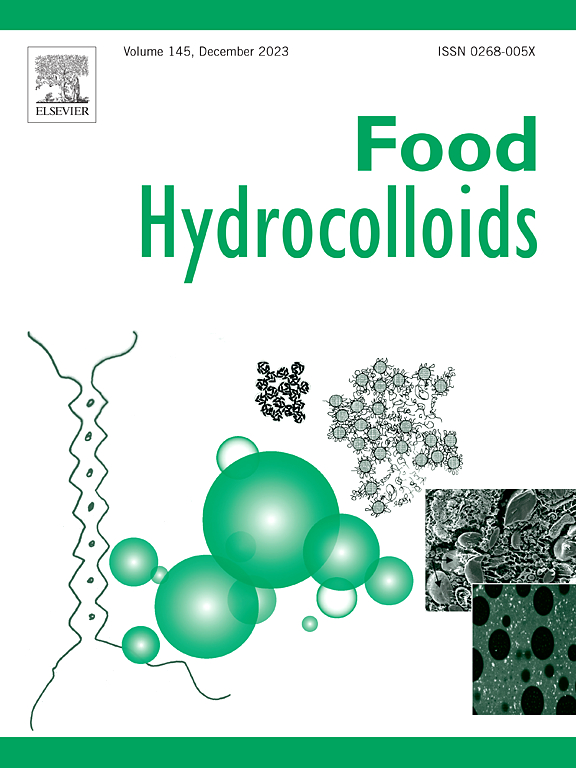Novel plant-based bigels formulated with sunflower wax, monoglycerides, agar and κ-carrageenan
IF 11
1区 农林科学
Q1 CHEMISTRY, APPLIED
引用次数: 0
Abstract
The development of novel plant-based bigel systems using agar, κ-carrageenan, sunflower wax (SW) and monoglycerides (MGs) was investigated in this work. The hydrogel phase was structured with 2 % agar and 1 % κ-carrageenan, while the olive oil oleogels were structured using either SW or a 1:1 mixture of MGs and SW, with concentrations ranging from 6 % to 12 % w/w. The effects of the type and concentration of oleogel phase gelators and the hydrogel-to-oleogel ratio (80:20, 60:40, 40:60, and 20:80) on the microstructural and physicochemical attributes, as well as the oxidative stability of these systems, were examined. All bigels were self-standing except for the 40:60 ratio and the 60:40 formulations containing 10 % and 12 % SW + MGs, which displayed phase separation. The hardness of the bigels increased as the proportion of hydrogel increased. Moreover, increased hardness was observed when MGs were present, in most cases. Microscopy analysis revealed that higher structurants concentrations in the 80:20 ratio resulted in smaller oil droplets and adding MGs led to a more uniform oil droplet size distribution. Differential scanning calorimetry and FTIR analyses revealed that the two structured phases interact mostly physically, without the formation of new chemical bonds. Furthermore, all bigels exhibited low swelling capacity (0.3–3.4 %) and effectively entrapped both water and oil, resulting in low total liquid release (1.02–3.46 %). These findings offer valuable insights into the structural and functional characteristics of plant-based bigels, which are important to consider on their future application in food products.

求助全文
约1分钟内获得全文
求助全文
来源期刊

Food Hydrocolloids
工程技术-食品科技
CiteScore
19.90
自引率
14.00%
发文量
871
审稿时长
37 days
期刊介绍:
Food Hydrocolloids publishes original and innovative research focused on the characterization, functional properties, and applications of hydrocolloid materials used in food products. These hydrocolloids, defined as polysaccharides and proteins of commercial importance, are added to control aspects such as texture, stability, rheology, and sensory properties. The research's primary emphasis should be on the hydrocolloids themselves, with thorough descriptions of their source, nature, and physicochemical characteristics. Manuscripts are expected to clearly outline specific aims and objectives, include a fundamental discussion of research findings at the molecular level, and address the significance of the results. Studies on hydrocolloids in complex formulations should concentrate on their overall properties and mechanisms of action, while simple formulation development studies may not be considered for publication.
The main areas of interest are:
-Chemical and physicochemical characterisation
Thermal properties including glass transitions and conformational changes-
Rheological properties including viscosity, viscoelastic properties and gelation behaviour-
The influence on organoleptic properties-
Interfacial properties including stabilisation of dispersions, emulsions and foams-
Film forming properties with application to edible films and active packaging-
Encapsulation and controlled release of active compounds-
The influence on health including their role as dietary fibre-
Manipulation of hydrocolloid structure and functionality through chemical, biochemical and physical processes-
New hydrocolloids and hydrocolloid sources of commercial potential.
The Journal also publishes Review articles that provide an overview of the latest developments in topics of specific interest to researchers in this field of activity.
 求助内容:
求助内容: 应助结果提醒方式:
应助结果提醒方式:


